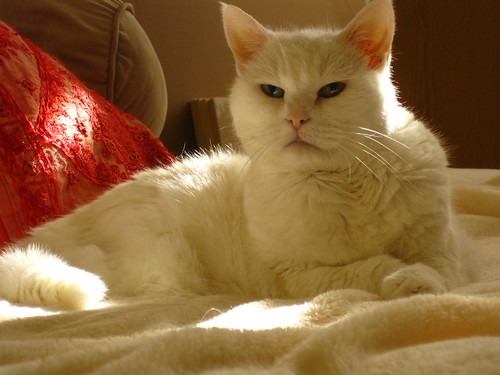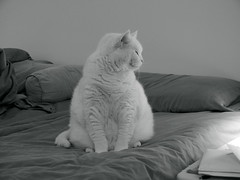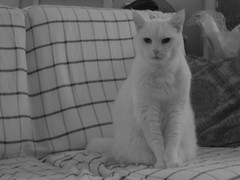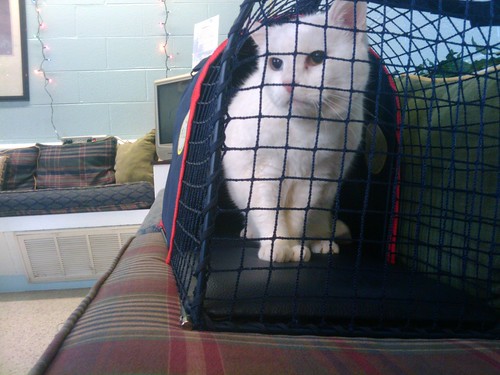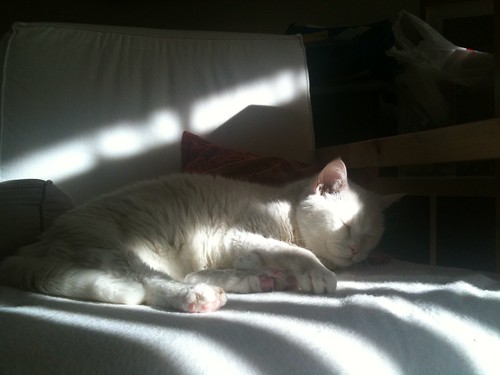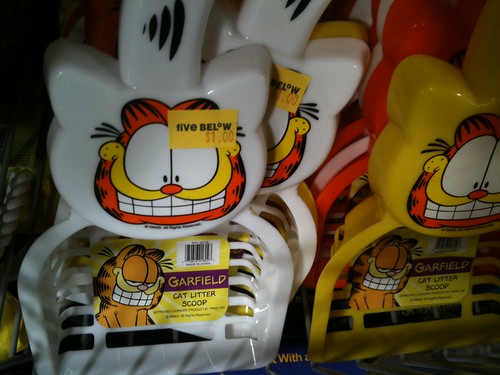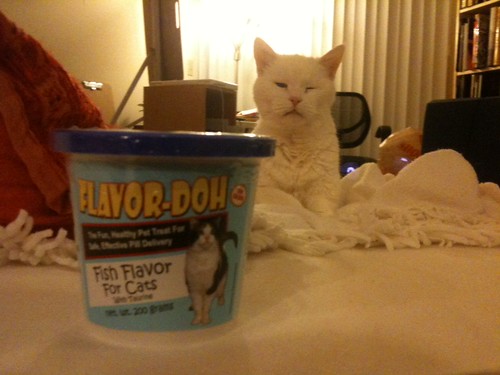Pandora the Cat is now 20 years old, and still enjoying a reasonably good quality of life, but her advanced years have seen many feline health difficulties common to cats her age.
Hyperthyroidism
It was shortly after our move to the new condo that Pandora lost weight precipitously, dropping from 16 to 8 pounds in under a year. While she had been previously overweight and had now reached just about average healthy weight for a senior cat, the suddenness of the weight loss, combined with apparent difficulty swallowing and periods of uncharacteristic agitation, prompted a blood test at the vet. Results showed hyperthyroidism, a common ailment in older cats.
Compare Pandora’s size between 2006 and 2010:
Caused by a swollen, sometimes cancerous thyroid gland overproducing hormones responsible for weight regulation and metabolism, hyperthyroidism eventually results in death by organ failure, and is most commonly treated with Methimazole (or Tapazole), a thyroid hormone inhibitor which the cat must ingest daily for the rest of her life. (We opted for this treatment rather than invasive surgery, or much pricier but more awesome radiation therapy which bombards the thyroid with cancer-targeting radiation beams — extremely effective, but leaves the cat a technical radioactive hazard for days after therapy, and the owner several thousand dollars poorer.)
Renal Failure
As Pandora’s thyroid levels stabilized, later blood tests showed elevated BUN and creatinine levels, blood markers for kidney dysfunction. High levels of these indicated that Pandora’s kidneys were not working as efficiently at removing these toxins from her bloodstream. Again, kidney failure is common in older cats, but in Pandora’s case the hyperthyroidism had masked this problem by elevating blood flow to her kidneys and causing them to function with deceptive efficiency. (Leaving her hyperthyroidism untreated for the sake of kidney function was not an option, as this would cause other metabolic complications, like hypertension and organ failure.)
It was a bit hard to notice the kidney issues because the symptoms were largely indistinguishable from Pandora’s usual troublesome behaviors — occasional litterbox aversion and vomiting. However, the vomiting had changed from hairballs to clear gastric acid spit-ups, and while her litterbox behaviors have improved over time she had begun going far more frequently since thyroid therapy had begun.
To address the gradual onset of renal failure, the vet prescribed Azodyl, a probiotic supplement consisting of yogurt-like cultures wrapped in an enteric capsule. The bacteria in the capsule bind to specific toxins in food so they flush from the intestine with solid waste before absorption into the bloodstream, thus cutting some of the kidneys’ filtering load.
Medication
Those of you with felines needing medication probably know what a trial it is to pill a cat. At various times I’ve tried Pill Pockets, prosciutto, bacon, yogurt, and Flavor Doh, but Pandora is a slow eater, picky and licky and quick to reject things that have pill smells.
The Tapazole pills are tiny enough to embed unnoticed in her canned food, but the Azodyl presents a special challenge since it comes in full size enteric capsules that even some humans would have difficulty swallowing, let alone house cats. The instructions recommend against opening or crushing the capsules, but there’s no avoiding it; the only solution that works for Pandora is to blend the probiotic powder into something more palatable to her. For a while she acquiesced to licking it with yogurt off a spoon. When she got tired of that, sprinkling it straight onto some tuna or other fishy-smelling cat food worked fairly well.
Veterinary compounding has been the best option for the Azodyl. A pharmacist at the Vienna Rexall down the road takes the powder and blends it into a grainy, tuna-flavored syrup. which I can then feed to Pandora via oral syringe. It’s still a bit of a struggle, but it goes down more quickly and easily, and is far less stressful for her than having a giant capsule forced down her throat after repeated attempts. Only problem: the compounded Azodyl is far less efficacious than the whole capsule. Apparently Vetoquinol has introduced small capsules, but they haven’t made it to my vet yet.
Still Alive
For now, Pandora is surviving remarkably well for 20. There are few signs of arthritis, and she’s even spry enough to venture out onto the balcony, or wake us up at 5AM by jumping onto the bed when she wants food. (She hasn’t been allowed on beds since the Pee Incident of 2005 so I have to wake up and carry her off to her bowl.)
For what it’s worth, she’s actually a bit healthier now thanks to the weight loss. Whereas she was well overweight before, her post-hyperthyroidism stabilized weight of 8 pounds is just about average for a senior Persian cat.
For now we make provisions for her gradually failing health with daily medication, frequent litterbox cleaning, and multiple layers of washable throws on the couch (her main hangout spot where she’s most likely to spit up a hairball or her last meal). Hopefully Pandora has many years left in her, and I’ll do all I can to make those years comfortable and painless.
Additional links:
Feline Adivsory Bureau page on hyperthyroidism
Veterinary imaging – feline hyperthyroidism
Tanya’s comprehensive guide to feline chronic kidney disease
Long-term Medical Management of Feline Chronic Renal Failure
